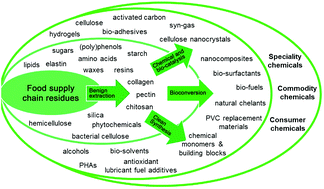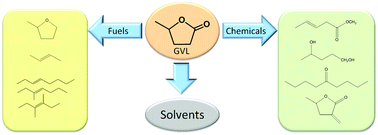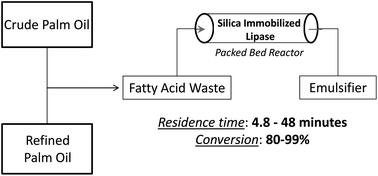Themed collection Green Chemistry and the Environment

Food waste biomass: a resource for high-value chemicals
The many food processes used in the food and drink industry globally generate food supply chain waste on a multi-tonne scale every year. Such resides include wheat straw surpluses, spent coffee grounds and citrus peels, all of which represent a resource for an integrated, product-focused biorefinery. Orange peel is particularly interesting, producing pectin and D-limonene using low-temperature microwave treatment and the running costs for a large scale have been estimated.

Green Chem., 2013,15, 307-314
https://doi.org/10.1039/C2GC36978H
Gamma-valerolactone , a sustainable platform molecule derived from lignocellulosic biomass
Gamma-valerolactone is a promising platform molecule derived from biomass that can be upgraded to both chemicals and fuels. Gamma-valerolactone production is closely linked to levulinic acid, which can be obtained from C6 and C5 sugars derived from lignocellulosic biomass.

Green Chem., 2013,15, 584-595
https://doi.org/10.1039/C3GC37065H
Valorisation of bakery waste for succinic acid production
In this paper, bakery waste, including cakes and pastries from Starbucks Hong Kong, was evaluated for the potential of succinic acid (SA) production.

Green Chem., 2013,15, 690-695
https://doi.org/10.1039/C2GC36518A
Continuous flow valorization of fatty acid waste using silica-immobilized lipases
Silica immobilized lipases have been prepared and utilized in the valorization of fatty acid-derived food waste streams under continuous flow conditions.

Green Chem., 2013,15, 518-524
https://doi.org/10.1039/C2GC36674F
Organic synthesis via magnetic attraction: benign and sustainable protocols using magnetic nanoferrites
Cu, Pd and Ru in nano form immobilized on magnetic ferrites enabled the development of sustainable procedures for azide–alkynes-cycloaddition (AAC) reactions, C–S coupling, O-allylation, Heck-type reactions and hydration of nitriles while glutathione bearing nano-ferrites serve as organocatalysts for the Paal–Knorr reaction and homocoupling of boronic acids.

Green Chem., 2013,15, 398-417
https://doi.org/10.1039/C2GC36455G
Palladium supported on an acidic metal–organic framework as an efficient catalyst in selective aerobic oxidation of alcohols
We report a highly active and selective heterogeneous Pd catalyst for liquid phase aerobic oxidation of a large variety of alcohols even under ambient conditions in the absence of any base additives.

Green Chem., 2013,15, 230-235
https://doi.org/10.1039/C2GC36618E
Pd(II)-catalyzed cycloisomerisation of γ-alkynoic acids and one-pot tandem cycloisomerisation/CuAAC reactions in water
Cycloisomerisation reactions of γ-alkynoic acids into exocyclic enol-lactones can be conveniently performed in water using trans-[PdCl2{μ2-N,S-(PTA)![[double bond, length as m-dash]](https://www.rsc.org/images/entities/char_e001.gif) NP(
NP(![[double bond, length as m-dash]](https://www.rsc.org/images/entities/char_e001.gif) S)(OEt)2}]2 as catalyst. One-pot tandem orthogonal cycloisomerisation/click chemistry reactions are for the first time reported under the principles of “Green Chemistry”, i.e. in water, at r.t., and under air.
S)(OEt)2}]2 as catalyst. One-pot tandem orthogonal cycloisomerisation/click chemistry reactions are for the first time reported under the principles of “Green Chemistry”, i.e. in water, at r.t., and under air.

Green Chem., 2012,14, 3190-3196
https://doi.org/10.1039/C2GC36176K
About this collection
This web collection contains selected contributions from the Symposium “Green Chemistry and the Environment” from the 244th American Chemical Society Fall National Meeting held from 19th-23rd August at Philadelphia (USA).
Significant efforts have been devoted in recent years to design innovative and efficient processes to reduce the impact of chemicals in the environment using green chemistry and low environmental impact technologies. Covering all topics all the way from biomass and waste valorisation to chemicals, fuels and materials using (bio)chemical methods to greener catalytic protocols, flow chemistry and process intensification, novel nanomaterials and greener semiconductors, this Green Chemistry web-themed issue addresses emerging strategies and technologies to advancing knowledge and efforts in our aim to switch to a more sustainable future society based on optimum practises and comparably efficient cost-competitive technologies as well as biobased derived products to replace current chemical processes and petrol-based products.
Professor Rafael Luque, Guest EditorUniversidad de Córdoba, Spain